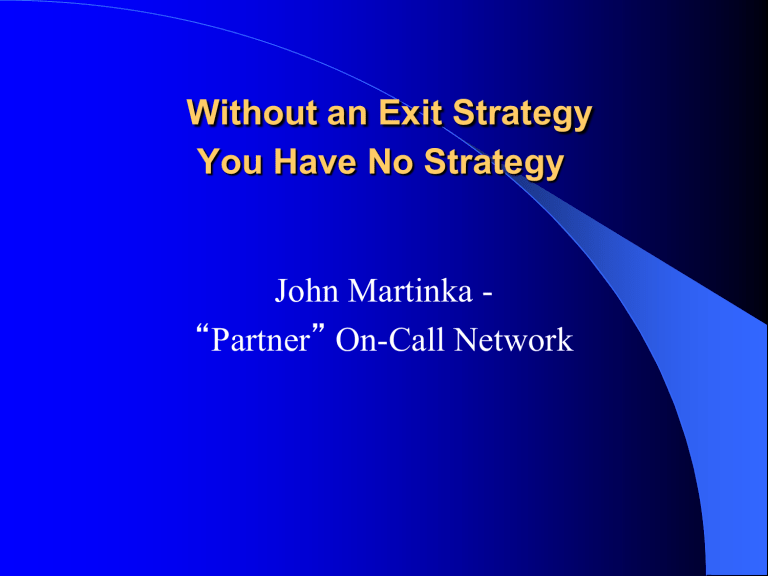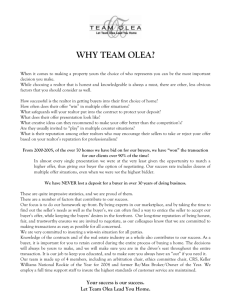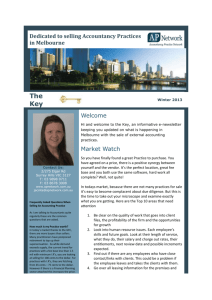action - sfsp.net

Without an Exit Strategy
You Have No Strategy
John Martinka -
“ Partner ” On-Call Network
Statistics
How many medium sized businesses are predicted to sell in the next decade?
Statistics
How many of these businesses are prepared for sale?
Statistics
According to Kiplinger, those companies without an exit strategy will _________
_______ ____ __ ________.
Statistics – SunTrust Bank
75% of business owners ultimately plan to sell or pass along their business as part of their exit plan
23% of owners are looking to expand and/or acquire other businesses
60% have delayed their exit plans by, on average, two years due to the Great
Recession
42% feel maximizing their business’s value is the most important part of their exit plan
Statistics – The Disconnect
11% of owners have lowered their expectations for the value of their business as a result of the current economy
(SunTrust)
Where does the Financial
Professional fit?
Financial Planning
Motivation
Team coordination
Protection and tax relief
Tax advantaged products
Compensation programs
Retirement plans
Statistics
The number one mistake small businesses make is ____________________.
Those with a business plan have, on average, sales and profit growth ____% more than those without a plan?
Decisions
What is my business worth?
Is it even salable?
Do I sell all or part of my business?
When? Now, six months or six years?
Who do I sell to?
Who Do I Sell To?
Outsiders
Insiders
Public Markets
And I get paid via:
Cash, Stock, Notes, Consulting Agreement,
Employment Agreement, Earnout…
Financial
Strategic
Hybrid
– Foreign
– PEG
Types of Buyers
Financial Buyers
•
•
•
•
• Individuals
Corporate refugees
Small business owners
Family
Employees
Financial Buyers Look For
Salary
Profits
Net worth increase
Salability in future
A job
Manageable risk
Statistics
There are ______ more people in the baby boomer generation than Gen X
Rank the generations in terms of entrepreneurship
___ Baby Boomer
___ Gen X
___ Gen Y
Strategic Buyers
Rapid growth potential
Management structure
Gross margin
Employees
Synergy
Excess overhead
Systems in place
Why do Strategic Buyers Buy?
People – Customers, Employees, Vendors
Geographic
Synergies, lower overhead, etc.
Equipment
Eliminate a competitor
To prove you can do it
Scaling = options & a higher selling price
Hybrid Buyers
Growth
Employees/Management
Solid practices
Stable, non-cyclical industry
A good “ feel ” (for the future)
Profit and salary
Your Situation
Who is your logical buyer?
Why me?
Why now?
What is their motivation?
Insurance
On the Seller
On the Buyer
Key Employee
Buy-Sell Agreement
Deferred Comp as part of the financing package
Why Sell a
Profitable Business?
Why Sell?
The 3 D ’ s a buyer looks for
Divorce
Death
Disability
The 3 D ’ s
Reasons affecting the owner
Divorce
Death
Disability
Burnout
Retirement
Family feud
Partnership dispute
Life
Earn a better return elsewhere
Company is part of larger firm
Company outgrows owner
Owner is an entrepreneur
Reasons affecting the business
Owner dies without succession plan
Catastrophic natural event
Uninsured damage or legal claims
Large loss of sales
Governmental actions or seizures
Political decisions
Fraud or theft
Wrong business decision
Strike or labor disruption
Lender changes terms of financing
Involuntary bankruptcy possible
When to sell?
Experts say get prepared ___ to ___ years before selling
Why?
___% of owners have to tell a “story”
Sell one year _____ ___ ___ _____ ___
Current Conditions
2011 market conditions
– Serious buyers, fewer in number though
– Serious sellers, coming out from their shell
– Willing banks???
What do they want?
What don’t they like?
– Is this business “ recession proof ”
Buy, Be Bought or Both
More buyer options
Higher multiple
More profits along the journey
More control
More cash at closing
What ’s it Worth?
It’s a function of profit (EBITDA, free cash flow, etc.)
If not, you better be attractive to bigger companies, or,
Your value is based on your net asset value
(and you’re worth less than the value based on profit )
What ’s it Worth?
From Rob Slee’s, “Midas Managers:”
$1-5MM in sales = 2-3 X EBITDA
$5-50MM in sales = 4-7 X EBITDA
You can bet a $40MM firm will get closer to
7X than a $5MM firm
Growth is the key
Strategic Buyers
Rapid growth potential
Management structure
Gross margin
Employees
Synergy
Excess overhead
Systems in place
A
C
T
I
O
N
ACTION ™ Plan
ACTION ™ Plan
Arrange all the affairs of the company
C
T
I
O
N
ACTION ™ Plan
Arrange all the affairs of the company
C oach and counsel the company. Its people, process and systems
T
I
O
N
ACTION ™ Plan
Arrange all the affairs of the company
C oach and counsel the company. Its people, process and systems
T ransmit and teach all the good “ things ” about your firm
I
O
N
ACTION ™ Plan
Arrange all the affairs of the company
C oach and counsel the company. Its people, process and systems
T ransmit and teach all the good “ things ” about your firm
I ntricacies that make your company special
O
N
ACTION ™ Plan
Arrange all the affairs of the company
C oach and counsel the company. Its people, process and systems
T ransmit and teach all the good “ things ” about your firm
I ntricacies that make your company special
Operations and management systems in place that will make a transition smooth
N
ACTION ™ Plan
Arrange all the affairs of the company
C oach and counsel the company. Its people, process and systems
T ransmit and teach all the good “ things ” about your firm
I ntricacies that make your company special
Operations and management systems in place that will make a transition smooth
Numbers, all the financials in understandable form, straightforward with no
“ tricks ”
6 Seller Pitfalls
6 Seller Pitfalls
No selling plan
Reason for selling
Weak non-financial factors
Not being prepared (tell a story)
Poor financial systems and records
Not properly screening buyers
Why? To get a deal done!
Savings & Investments
Private party loan to buyer
Buy excess assets and sell off
Buy inventory as needed
Sell shares to employees
Recruit equity partner
Buy cash and Accounts Receivable
Balloon payments, interest only loans, etc.
SBA guaranteed bank loan – current situation
401k rollover (Guidant Financial, Bellevue)
Insurance
Case Study – Industry Buyer
Management structure
Protecting trade secrets
The buyer wants…?
Employees
Lease, etc.
Culture
The seller’s role post-sale
Case Study – Industry Buyer
Service Business
Quasi competitors (different cities)
Buyer was 5-7X as big
Weak management structure (seller)
Lease, equipment, T1 lines, etc.
Culture differences
Seller to remain in a sales role
Case Study – Industry Buyer
Background – the story
Planning yields benefits
Results
Industry offers
Seller’s next step
The return
A deal, a post-mortem
Case Study – Industry Buyer
Insurance needs–Where do you see a need?
Buyer
Seller
Management
Pension
Benefits
Case Study – Family Sale
Who? Kids, one kid, management?
Do they want the business?
Do they want the responsibility?
Will they put any money in the deal?
Do they expect a gift?
What’s it worth?
How long do mom and/or dad stay on?
Case Study – Family Sale
Distribution Company
Discussion issues:
– Who?
– When?
– How?
– Future success?
– If one child, what about the others?
– Payment (this is mom & dad’s retirement)
Case Study – Family Sale
Distribution Company
Dad bought company
Mom kept job, came on board later
Dad-CEO; Mom-CFO
Fast growth with both in management roles
Initial valuation
Business plan for growth
Family succession or outside buyer?
Case Study – Family Sale
Distribution Company
Son got outside experience
Hired son as salesperson
Promoted to sales manager
Gift of 10% of stock
Daughter-in-law hired as office manager
Second valuation
20-year payment plan from son to parents
Case Study – Family Buyer
Insurance needs–Where do you see a need?
Kids
Parents
Management
Pension
Benefits
Keep in touch
John Martinka
425-576-1814
partneroncall/johnmartinka.com
john@johnmartinka.com
Blog: johnmartinka.com
Free e-mail newsletter “ The Business Buy,
Sell & Growth Advisor ”











